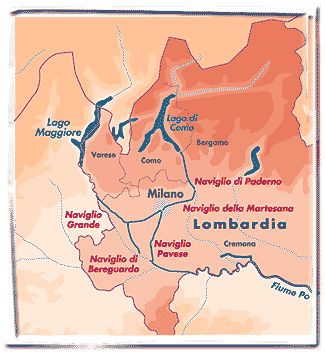| |
The VEV network was bound to pay homage to Italy, cradle of the
European Renaissance, where mathematicians and engineers had become
the masters of canal construction in the 15th century. Italy certainly
takes credit for introducing double, swinging mitre lock gates
of the type still used almost universally today.
The "Naviglio" di Martesana, built between 1462 and
1470 by Bertola da Novate (1410-1475), is an example. Diverting
flow from the river Adda at Trezzo, it follows the course of this
river for 8 km before heading west across the plain of Lombardy
to Milan, covering a total distance of 38 km. It was originally
built with two locks and an aqueduct with three spans of 18m across
the river Molgora. This aqueduct was the first to be built exclusively
for navigation. Smaller streams were culverted under the canal
by siphons of a design adopted later by the engineers of the Canal
du Midi.
Leonardo da Vinci contributed to the improvement of lock design
and building techniques. He also designed the first project for
a lateral canal at Paderno, to by-pass the rapids of Adda and
thus fulfil the Milanese dream of an uninterrupted inland waterway
between Milan and Lake Como. The idea matured thanks to dedication
of architect and painter Giuseppe Meda, author in 1574 of a remarkably
ambitious project on this difficult site, with a lock of almost
18m drop. Construction of the Paderno Canal was finally approved
by the King of Spain in 1590, but work proceeded slowly, in a
political and economic context that was fraught with difficulty.

Meda died in August 1599, and with him
all ambitions for completion of the enterprise. The water introduced
into the first section in 1603 was drained completely in 1617.
The towns of Como and Bergamo kept up their fierce opposition
to this navigable link, which threatened their respective trading
positions. A new "grand design" was needed to put the
project back on the agenda. This was the case under the Austrian
administration (1748-1796).
The studies were revised by count Firmian, representative of Austria
in Lombardy, who asked the engineers and mathematicians Pecis,
Lecchi, De Regis and Frisi to conduct the work. Contractor Nosetti
was awarded the works in 1773. The project provided for reuse
of Meda's lock foundations, but with the height of the downstream
lock reduced to about a third of that in Meda's original plan.
Nosetti doubted the feasibility of a lock as deep as that proposed
by Meda, and envisaged breaking up the difference in level of
30m into six pounds instead of two. The canal was opened to navigation
on October 11, 1777 in the presence of count Firmian and the Archduke
of Austria. However, a structural failure at one of the locks
delayed final opening of the canal until two years later.
While commercial navigation declined during the 19th century,
other uses appeared or expanded, in particular irrigation, and
towards the end of the century the landscape of the Adda valley
was totally transformed by the arrival of hydroelectric power.
The heritage of the valley of Adda is thus today a valuable combination
of technical monuments and natural landscapes, the conservation
of which has became a specific issue for the Region, despite the
fact that the canals have been abandoned as navigations. Their
restoration, for uses that remain to be defined, is now clearly
on the agenda, and the Region intends to make a success of their
rehabilitation as visitor routes, a leisure amenity for the Milanese
conurbation and infrastructure for didactic projects on the history
of the hydraulic techniques, omnipresent in the region.
|
|



